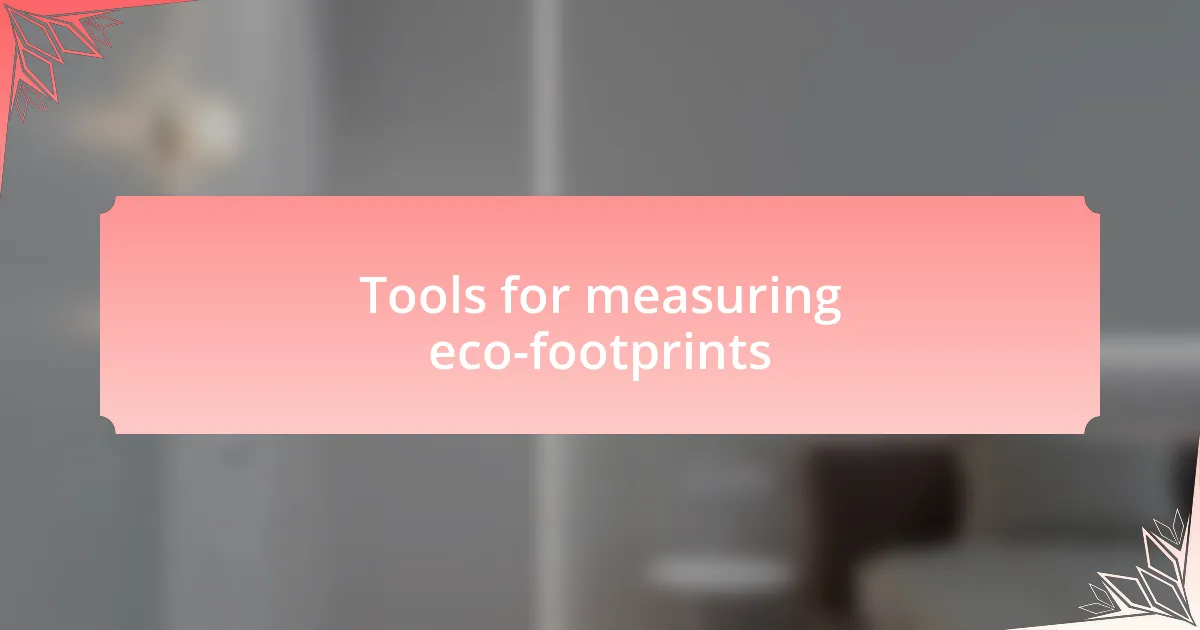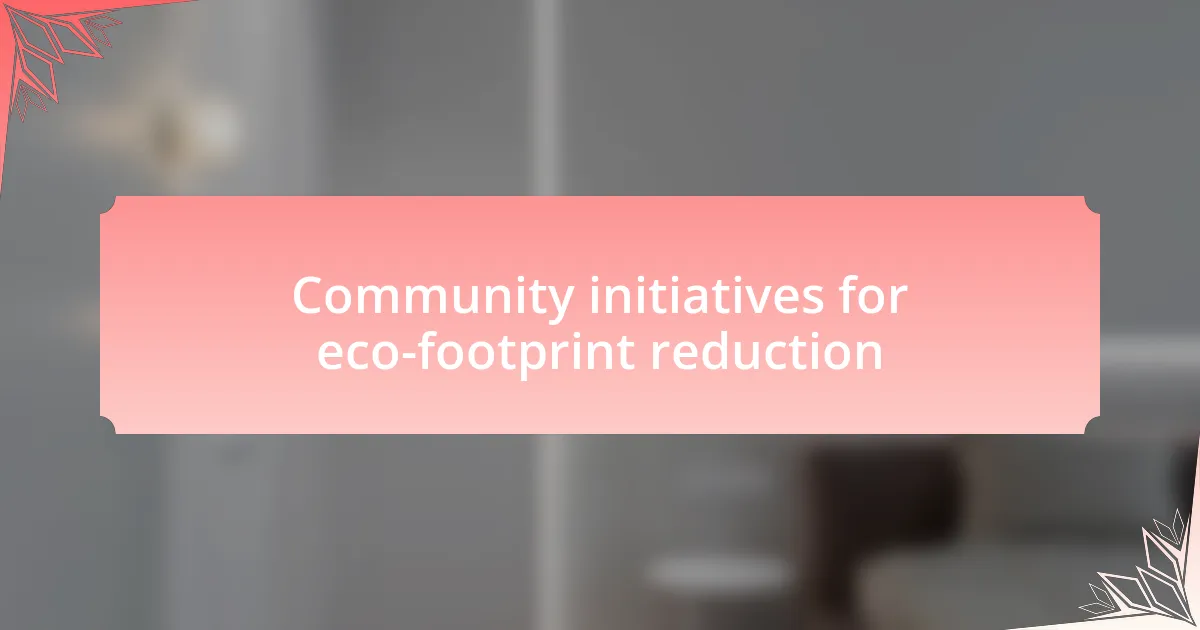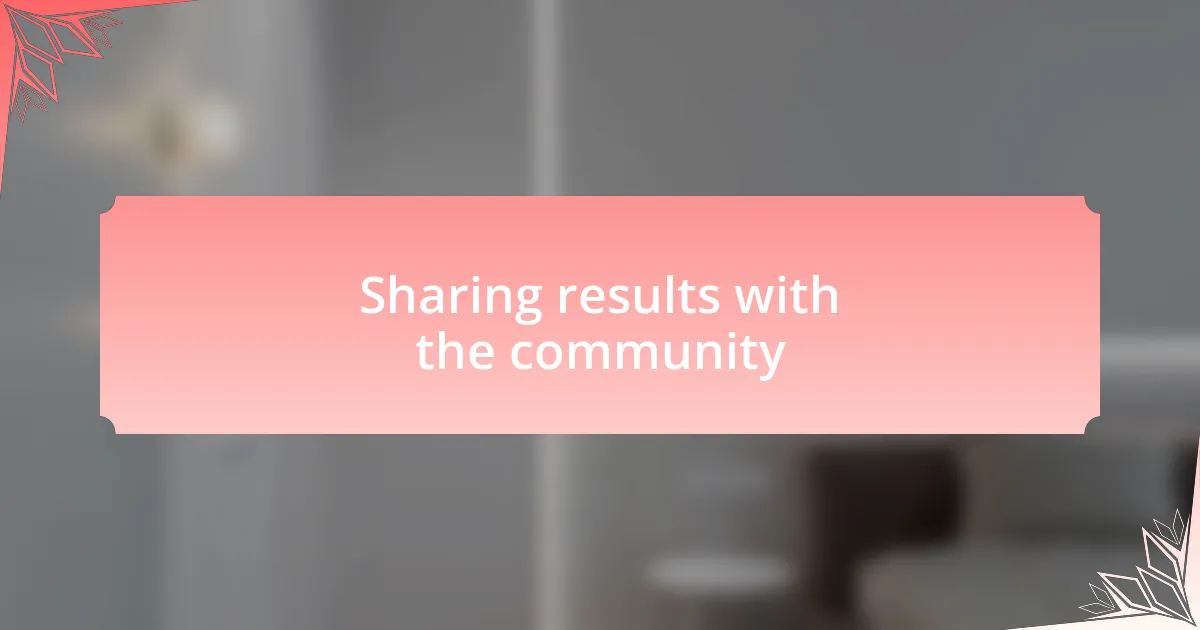Key takeaways:
- Understanding eco-footprints helps individuals recognize their environmental impact and identify areas for improvement.
- Tracking eco-footprints empowers personal accountability, inspires communal change, and fosters a sense of purpose in adopting sustainable practices.
- Community initiatives, like tree-planting events and gardening projects, promote collective eco-consciousness and strengthen local connections.
- Sharing eco-footprint results with the community creates accountability and encourages others to adopt sustainable habits, fostering a supportive environment for change.

Understanding eco-footprints
An eco-footprint represents the total amount of natural resources consumed by an individual, community, or organization, scaled down to a measurable metric, usually in acres or hectares. I remember when I first calculated my footprint; it was eye-opening to see how my daily choices, from packaging waste to energy consumption, directly impacted our planet. It really made me ponder—how often do we stop to consider the environmental cost of our convenience?
Understanding eco-footprints is crucial because it not only shows where we stand but also highlights areas for potential improvement. I found my own footprint surprisingly large, mainly due to my car usage and the energy I was wasting at home. It struck me that small shifts in behavior, like using public transport or switching to energy-efficient appliances, could significantly reduce my impact.
This concept invites deeper reflection: what if we all became more conscious of our choices? Imagining entire communities making sustainable swaps sparked a sense of hope in me. It’s fascinating to think about how collective awareness can lead to substantial change, fostering a shared responsibility for our environment.
![]()
Importance of tracking eco-footprints
Tracking eco-footprints is essential because it empowers us to understand the real impact of our lifestyle choices. For instance, when I began monitoring my habits, I noticed how my love for takeout often resulted in excessive plastic waste. This realization forced me to reconsider not just what I was consuming but how those choices contributed to environmental degradation.
Beyond personal insights, keeping an eye on our eco-footprint can inspire communal change. When I shared my findings with friends, many were astonished to learn how simple actions—like bringing reusable bags or choosing local products—could collectively transform our community’s environmental health. It makes me wonder: what changes could we spark if everyone actively tracked and refined their impact?
Lastly, the act of tracking can also foster accountability. When I set eco-goals for myself, I felt a newfound sense of purpose driving my daily actions. It’s almost as if documenting my journey became a catalyst for continuous improvement, nudging me closer to a sustainable lifestyle each day. So, how can we ignore the profound difference tracking our eco-footprint can make, not just for ourselves, but for the world around us?

Tools for measuring eco-footprints
Tracking my eco-footprint has been greatly enhanced by a few reliable tools available today. One of my favorites is an online carbon calculator, which breaks down my emissions based on my daily activities, from transportation to energy consumption. The first time I used it, I was shocked to see how much my daily commute contributed to my overall footprint. Have you ever had a similar eye-opening experience?
Another tool I’ve found invaluable is mobile apps tailored for eco-tracking. They allow me to log my purchases and energy use in real time, making it easy to identify areas where I can cut back. I remember one day after entering my grocery list, the app highlighted my excessive use of packaging—prompting me to seek out zero-waste stores nearby. That small moment shifted how I approached my shopping trips completely, making each outing feel more intentional.
Lastly, community engagement platforms play a significant role in tracking our collective impact. These networks allow me to share my journey and challenges while learning from others in the community. When I connect with like-minded individuals, it deepens my commitment to sustainability. It’s empowering to see how our combined efforts can spark local initiatives that promote eco-friendly practices. How might we leverage these tools to create a more sustainable community together?

Strategies to reduce eco-footprints
Adopting a plant-based diet has been one of the most impactful changes I’ve made to reduce my eco-footprint. I can’t tell you how surprising it was to discover that shifting just one meal a day to a meatless option significantly lowers greenhouse gas emissions. Have you ever thought about how your food choices affect the planet? It really made me rethink what I put on my plate.
Another practical strategy I’ve embraced is reducing single-use plastics. For instance, I’ve switched to reusable bags and water bottles, which not only cut down my waste but also save me money in the long run. I distinctly remember feeling a sense of pride on my last shopping trip when I realized I wouldn’t need a single plastic bag. Seeing my commitment translate into a tangible difference feels incredibly rewarding.
Lastly, I prioritize energy-efficient practices at home, like using LED bulbs and unplugging devices when not in use. One day, I stumbled upon my energy bill, and to my delight, noticed a significant drop just from being mindful about my energy consumption. Isn’t it fascinating how small daily habits can lead to big savings—both for our wallets and the environment? It’s those little choices that contribute to a larger change over time.

Community initiatives for eco-footprint reduction
Community initiatives play a crucial role in reducing our collective eco-footprint. I remember attending a local tree-planting event, where neighbors came together not just to plant saplings but also to share stories about the importance of green spaces. Isn’t it incredible how something as simple as planting a tree can foster connections among community members while promoting biodiversity?
Another noteworthy initiative I’ve witnessed is the establishment of a community garden. This space not only provides fresh produce but also serves as a hub for workshops on sustainable gardening practices. Participating in these events has truly opened my eyes to how communal efforts can transform unused land into thriving ecosystems. It makes you wonder: what untapped potential lies in our neighborhoods?
Moreover, many communities are now organizing carpool programs or promoting public transportation usage. I joined a carpool with a few colleagues, which not only reduced our carbon emissions but also created a wonderful camaraderie among us. Have you ever noticed how reducing the number of cars on the road enhances the sense of teamwork and fosters a closer-knit community?
![]()
Personal eco-footprint tracking methods
One effective method I’ve embraced to track my eco-footprint is through mobile apps specifically designed for sustainability. These apps can break down my daily habits—like energy consumption, water usage, and even food choices—into digestible insights. I remember the first time I logged my meals; seeing the carbon footprint for each item made me reconsider my grocery choices. Have you ever thought about how your diet impacts the planet?
Another approach I find incredibly useful is maintaining a simple eco-journal. Each week, I jot down specific actions I took that either helped or hindered my eco-footprint. Reflecting on moments like reducing plastic use or finding alternatives for waste has been eye-opening. It’s fascinating to see patterns develop over time; it’s almost like a personal journey toward sustainability that inspires me to make better choices.
Lastly, I’m a firm believer in participating in local workshops focused on eco-living. These events not only provide practical tips but also allow for meaningful discussions about our collective impact. I once attended a session on minimalism, and it radically shifted my mindset on consumption. Have you ever left a workshop feeling empowered and ready to take on the world? That sense of motivation can truly spark lasting change in how we live our lives.

Sharing results with the community
One of the most rewarding aspects of tracking my eco-footprint is sharing the results with my community. After I compiled my monthly data, I hosted a small gathering to discuss our collective findings. The reaction was eye-opening; seeing friends become animated while sharing their experiences reminded me of the power of transparency. Have you noticed how sharing creates a sense of accountability?
I also began joining a local online forum where residents exchange their eco-footprint statistics. It surprised me how this simple act fostered a supportive environment—people celebrate each other’s milestones, no matter how small. For example, one neighbor shared that switching to a plant-based diet reduced his footprint remarkably. Isn’t it incredible how our individual choices can inspire a ripple effect in the community?
Moreover, I love organizing eco-themed events where we present our collective results, making it a fun and engaging experience. At our last event, we set up an eco-footprint display, showcasing everyone’s efforts, and the energy in the room was palpable. Seeing people recognize their contributions sparked conversations about potential group initiatives, like community gardens. Have you ever experienced that electrifying moment when everyone comes together with a shared purpose? It’s that unity that truly amplifies our impact.